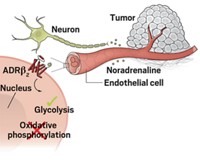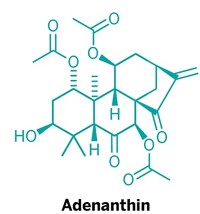Advertisement
Grab your lab coat. Let's get started
Welcome!
Welcome!
Create an account below to get 6 C&EN articles per month, receive newsletters and more - all free.
It seems this is your first time logging in online. Please enter the following information to continue.
As an ACS member you automatically get access to this site. All we need is few more details to create your reading experience.
Not you? Sign in with a different account.
Not you? Sign in with a different account.
ERROR 1
ERROR 1
ERROR 2
ERROR 2
ERROR 2
ERROR 2
ERROR 2
Password and Confirm password must match.
If you have an ACS member number, please enter it here so we can link this account to your membership. (optional)
ERROR 2
ACS values your privacy. By submitting your information, you are gaining access to C&EN and subscribing to our weekly newsletter. We use the information you provide to make your reading experience better, and we will never sell your data to third party members.
Pharmaceuticals
A Fat Chance To Cure Cancer
Blocking fatty acid assembly is a potential strategy against disease
by Carmen Drahl
June 23, 2008
| A version of this story appeared in
Volume 86, Issue 25

Orlistat is not a cancer drug, which is why Lowther had to say no. One of its targets, however, is generating excitement as a potential entryway to a new class of cancer therapies. In addition to its primary mechanism of action—inhibition of pancreatic lipase—orlistat targets a biochemical hallmark that many tumor cells have in common—increased fatty acid production. Although several lines of evidence suggest that this strategy effectively kills cancer in the lab, questions remain before a compound targeting fatty acid production can reach clinical trials in human patients.
Because every cell in the body needs fats to survive, one might think that blocking fatty acid assembly would be a losing proposition. Not so, according to chemist Craig A. Townsend of Johns Hopkins University, who is also working on this strategy. "What people have failed to realize until recently is that the biochemistries of a normal cell and of a cancer cell are fundamentally different," he says. Normal cells obtain fatty acids from the diet, he says, and make fats mainly in liver and fatty tissue, where energy is stored as fat. Cancer cells don't store fat, yet they have elevated levels of the enzyme that makes fatty acids. That protein factory is called fatty acid synthase. Researchers have evidence that it plays a role in cancer and can be targeted selectively without harming normal cells.
Because cancer cells have much higher levels of fatty acid synthase than normal cells, selective targeting should be possible. Researchers have also done the genetic groundwork to show that taking fatty acid synthase away from cancer cells kills them or keeps them from growing without harming normal cells. Treating tumors in mice or tumor cell cultures with small-molecule fatty acid synthase inhibitors does the same thing.
Why these experiments work isn't clear, however, according to Jeffrey W. Smith of the Burnham Institute, in La Jolla, Calif. He led the team that discovered that orlistat blocks fatty acid synthase. It may be, he says, that cancer cells use the pathway not because they need a lot of fatty acids but instead to help maintain redox balance. What's more, he adds, "no clinical trials have been conducted to say that fatty acid synthase is a valid target in humans."
FATTY ACID synthase carries out cycles of chain-building chemistry, like a microscopic assembly line. The enzyme's seven domains each catalyze a different reaction. Most efforts in developing new cancer drugs against this enzyme have focused on two of these domains, a thioesterase, which cleaves the completed fatty acid chain from the enzyme and is a secondary target of orlistat, and a β-ketoacyl synthase, which attaches an activated two-carbon compound to the growing fatty acid chain.
The ability to design inhibitors of the thioesterase got a boost from Kridel and Lowther's X-ray crystal structure, which is the only published structure of human fatty acid synthase domain with binding a drug (Nat. Struct. Mol. Biol. 2007, 14, 704).
Daniel Romo at Texas A&M University, College Station, is one chemist making use of that structure. He is an expert on the synthesis of molecules that, like orlistat, contain a reactive β-lactone group. His team, in collaboration with Smith's, makes derivatives of orlistat to determine which features of the molecule are most important for fatty acid synthase inhibition (Bioorg. Med. Chem. Lett. 2008, 28, 2491; Org. Lett. 2006, 8, 4497).
It's important to realize, Smith says, that orlistat is not FDA-approved for treating cancer. When taken as a pill, orlistat doesn't enter the blood in high enough concentrations to affect tumor cells, he adds. Kridel and Lowther speculate that finding a better way to deliver orlistat or its analogs to tumor tissues might improve its anticancer potential.
Getting fatty acid synthase inhibitors for treating cancer where they need to be is a challenge in general, one that is not limited to thioesterase inhibitors, Townsend says. For example, a research team at GlaxoSmithKline recently showed that a selective and potent inhibitor for yet another domain within fatty acid synthase, a β-ketoacyl reductase, could not efficiently penetrate cells (FEBS J. 2008, 275, 1556).
Townsend's team is trying something else: developing blockers of the β-ketoacyl synthase domain. One appeal of this domain as a target for chemotherapy drugs, Smith says, is that the enzyme is the only one of its kind in the human genome, so it might be easier to design an inhibitor that will selectively target it. Townsend and his collaborator Francis P. Kuhajda, also of Johns Hopkins, agree. They are cofounders of FASgen, a start-up company dedicated to discovering fatty acid synthase-targeting drugs for cancer and other applications.
One of their early β-ketoacyl synthase inhibitors, called C75, blocked fatty acid synthesis inside cells but induced severe weight loss in mice. The team eventually found out that C75 also activated other proteins that stimulated fat-burning, which caused the side effect. This finding, Kuhajda says, meant that the selectivity of future generations of inhibitors could be tuned to avoid the side effect.
Indeed, his team recently found a β-ketoacyl synthase inhibitor, C93, that blocked lung cancer cell growth in mice without causing weight loss (Clin. Cancer Res. 2007, 13, 7139). Kuhajda and Townsend have not yet disclosed C93's structure, but they tell C&EN that FASgen is focusing on developing a few compounds, with the intent of submitting an Investigational New Drug Application to FDA sometime in 2009.
The chances of finding a drug candidate are good, Lowther believes, because of the sheer chemical diversity of compounds that have already been effective against the enzyme in assays.
Even though narrowing down the seemingly limitless number of chemical possibilities will be a daunting task, Kridel is motivated to keep going. Not every phone call or e-mail he gets from a patient is frustrating. One cancer patient told Kridel that reading news about cancer research advances gives him hope. "Even though it's only a few e-mails, they really remind you that you're doing a worthwhile thing," Kridel says.






Join the conversation
Contact the reporter
Submit a Letter to the Editor for publication
Engage with us on Twitter